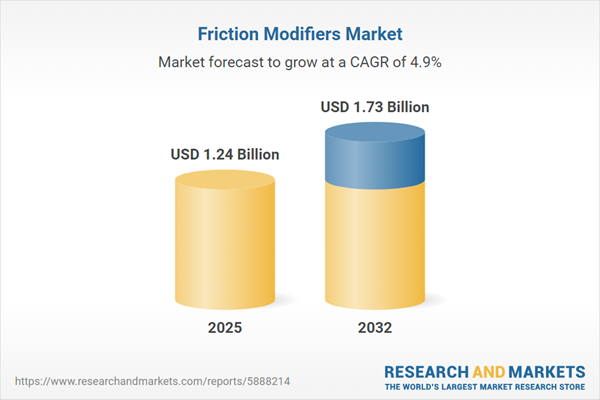Speak directly to the analyst to clarify any post sales queries you may have.
The friction modifiers market plays a crucial role in supporting operational efficiency and equipment longevity across core industrial sectors. As industries prioritize reliability, sustainability, and performance, friction modifiers are emerging as essential components in advanced lubricant and machinery solutions.
Market Snapshot of the Friction Modifiers Market
The Friction Modifiers Market grew from USD 1.18 billion in 2024 to USD 1.24 billion in 2025. It is expected to continue growing at a CAGR of 4.91%, reaching USD 1.73 billion by 2032.
Friction modifiers enable machinery and critical components to operate with less wear, lower maintenance demands, and increased process uptime. Growing focus among manufacturers and OEMs on optimizing total cost of ownership accelerates the adoption of advanced, sustainable additive chemistries and digital performance analytics. Regional market dynamics and regulatory factors are also shaping both procurement and R&D strategies.Scope & Segmentation of the Global Friction Modifiers Market
- Type – Ceramic-Based (including aluminum oxide, silicon carbide); Composite (carbon-based, ceramic-metal, metal-polymer); Oil-Based (mineral oil, synthetic oil); Polymer-Based (polyurethane, PTFE, silicone); Solid (boron nitride, graphite, molybdenum disulfide).
- Form – Emulsion (oil-in-water, water-in-oil); Liquid (mineral oil solution, synthetic oil solution); Paste (grease-based, wax-based); Powder (graphite powder, molybdenum disulfide powder, polymer powder).
- End-Use Industry – Aerospace (commercial and military aircraft); Automotive (commercial vehicles, passenger vehicles); Energy & Power (hydro turbine, oil & gas equipment, wind turbine); Industrial Machinery (heavy machinery, manufacturing equipment); Marine (commercial shipping, passenger ships).
- Application – Corrosion Protection (additives, coatings); Friction Reduction (brake systems, engine components, gear systems); Wear Resistance (bearings, seals, valves).
- Region – Americas (North America: United States, Canada, Mexico; Latin America: Brazil, Argentina, Chile, Colombia, Peru); Europe, Middle East & Africa (Europe: United Kingdom, Germany, France, Russia, Italy, Spain, Netherlands, Sweden, Poland, Switzerland; Middle East: UAE, Saudi Arabia, Qatar, Turkey, Israel; Africa: South Africa, Nigeria, Egypt, Kenya); Asia-Pacific (China, India, Japan, Australia, South Korea, Indonesia, Thailand, Malaysia, Singapore, Taiwan).
- Companies Profiled – The Lubrizol Corporation, Afton Chemical Corporation, Infineum International Limited, Chevron Oronite Company LLC, BASF SE, Croda International Plc, Innospec Inc., Evonik Industries AG, Emery Oleochemicals, LLC, Italmatch Chemicals S.p.A.
Key Takeaways for Decision-Makers
- Advanced friction modifiers now frequently integrate nano-engineered and bio-based chemistries, enabling sustained performance in demanding applications while supporting sustainability mandates.
- Collaboration between chemical producers, research institutions, and OEMs is accelerating product development, with mutual focus on optimizing tribological properties and supply chain agility.
- Digital performance analytics and real-time monitoring capabilities are reshaping service models, offering predictive insights and data-driven maintenance strategies to industrial and automotive customers.
- Adoption trends vary by region, with Asia-Pacific leading demand due to manufacturing growth, while North American and European markets are driven by emissions regulation and energy efficiency programs.
- Industry partnerships, mergers, and acquisitions—particularly those involving niche additive firms or innovative start-ups—are shaping competitive positioning and supporting rapid market expansion.
Tariff Impact on Market Dynamics
With additional United States tariffs imposed in 2025, supply chains for friction modifiers have adapted through reconfigured sourcing, localized production, and inventory management strategies. Producers in tariff-exempt regions are leveraging competitive advantages, while global manufacturers are investing in regional supply chain resilience and diversification to reduce exposure to ongoing trade policy changes.
Methodology & Data Sources
This research combines primary interviews with industry experts, systematic assessment of technical literature, and analysis of regulatory documents. Data integrity is ensured through triangulation with secondary sources from trade associations and peer-reviewed journals, reinforced by data cleansing and validation protocols throughout each stage.
Why This Report Matters
- Provides data-driven insights to optimize R&D, procurement, and go-to-market strategies within the friction modifiers landscape.
- Highlights emerging opportunities and supply chain challenges, empowering decision-makers to support operational excellence and long-term growth.
- Enables strategic benchmarking against key regional, technological, and competitive trends for both established players and market entrants.
Conclusion
The evolving friction modifiers market is defined by ongoing innovation, digital transformation, and supply chain agility. Organizations prioritizing advanced materials, sustainable practices, and collaborative service models will be best positioned for resilient, sustainable growth.
Additional Product Information:
- Purchase of this report includes 1 year online access with quarterly updates.
- This report can be updated on request. Please contact our Customer Experience team using the Ask a Question widget on our website.
Table of Contents
3. Executive Summary
4. Market Overview
7. Cumulative Impact of Artificial Intelligence 2025
Companies Mentioned
The companies profiled in this Friction Modifiers market report include:- The Lubrizol Corporation
- Afton Chemical Corporation
- Infineum International Limited
- Chevron Oronite Company LLC
- BASF SE
- Croda International Plc
- Innospec Inc.
- Evonik Industries AG
- Emery Oleochemicals, LLC
- Italmatch Chemicals S.p.A
Table Information
| Report Attribute | Details |
|---|---|
| No. of Pages | 182 |
| Published | October 2025 |
| Forecast Period | 2025 - 2032 |
| Estimated Market Value ( USD | $ 1.24 Billion |
| Forecasted Market Value ( USD | $ 1.73 Billion |
| Compound Annual Growth Rate | 4.9% |
| Regions Covered | Global |
| No. of Companies Mentioned | 11 |









